Презентация bridges over the fontanka river



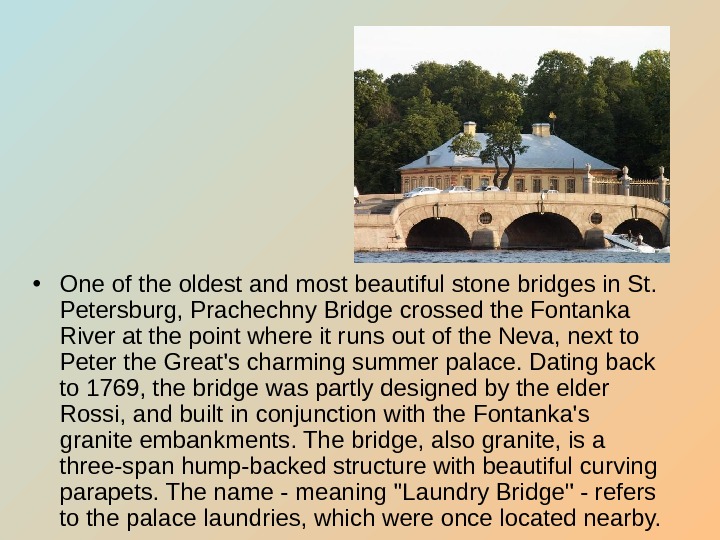

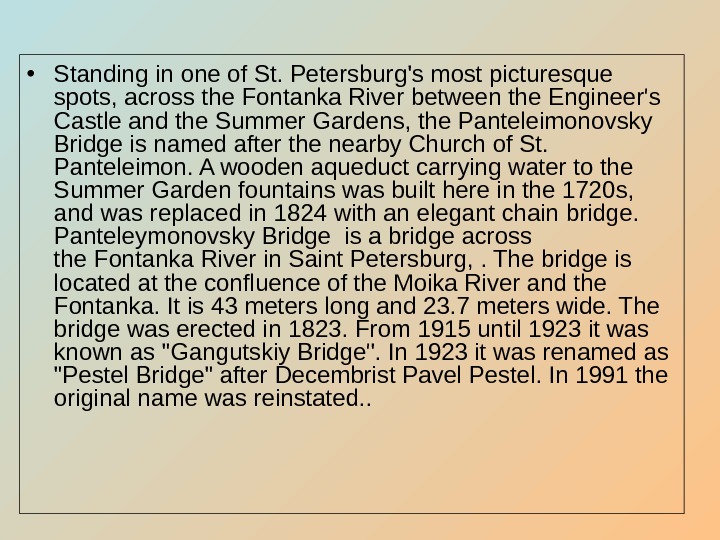


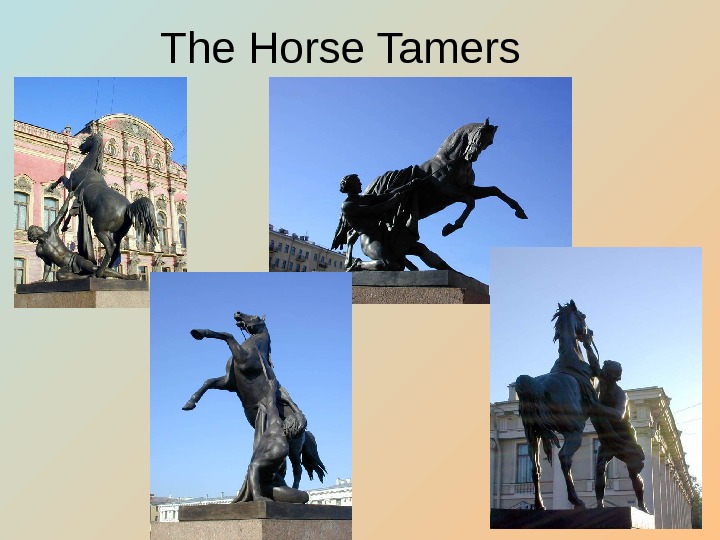

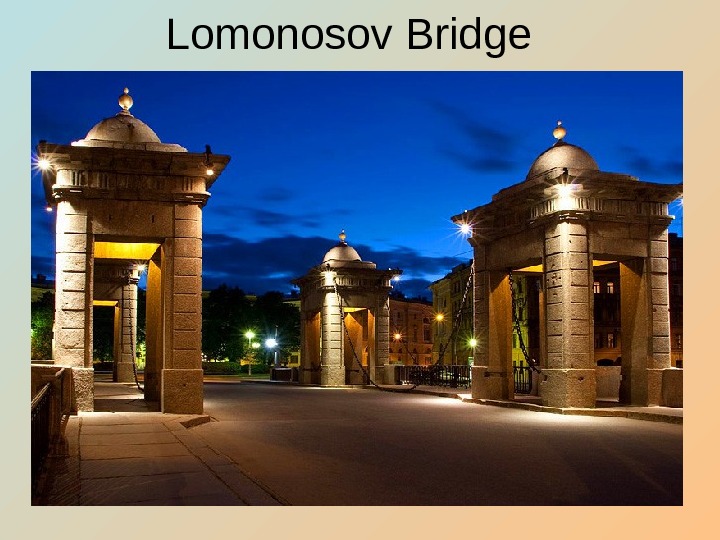


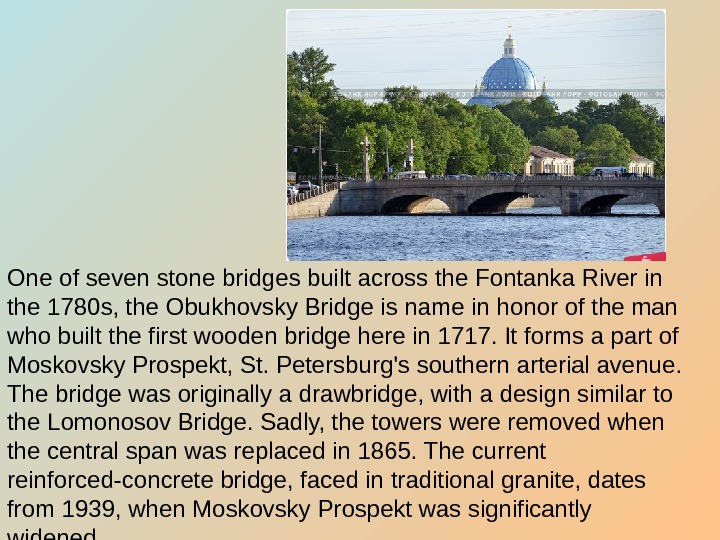




- Размер: 1.8 Mегабайта
- Количество слайдов: 17
Описание презентации Презентация bridges over the fontanka river по слайдам
 • St. Petersburg is known as the «Venice of the North» and the city’s many rivers and canals are decorated with some of the most beautiful bridges in the world. In fact, St. Petersburg is also sometimes known as the «City of 300 Bridges, » though there actually 342. Small rivers and canals dissect the historic centre of St. Petersburg, and it’s hard to walk more than a few hundred meters without crossing a bridge. Our directory of St. Petersburg Bridges includes over sixty of the most interesting and beautiful bridges in the centre of St. Petersburg
• St. Petersburg is known as the «Venice of the North» and the city’s many rivers and canals are decorated with some of the most beautiful bridges in the world. In fact, St. Petersburg is also sometimes known as the «City of 300 Bridges, » though there actually 342. Small rivers and canals dissect the historic centre of St. Petersburg, and it’s hard to walk more than a few hundred meters without crossing a bridge. Our directory of St. Petersburg Bridges includes over sixty of the most interesting and beautiful bridges in the centre of St. Petersburg
 Prachechny Bridge
Prachechny Bridge
 • One of the oldest and most beautiful stone bridges in St. Petersburg, Prachechny Bridge crossed the Fontanka River at the point where it runs out of the Neva, next to Peter the Great’s charming summer palace. Dating back to 1769, the bridge was partly designed by the elder Rossi, and built in conjunction with the Fontanka’s granite embankments. The bridge, also granite, is a three-span hump-backed structure with beautiful curving parapets. The name — meaning «Laundry Bridge» — refers to the palace laundries, which were once located nearby.
• One of the oldest and most beautiful stone bridges in St. Petersburg, Prachechny Bridge crossed the Fontanka River at the point where it runs out of the Neva, next to Peter the Great’s charming summer palace. Dating back to 1769, the bridge was partly designed by the elder Rossi, and built in conjunction with the Fontanka’s granite embankments. The bridge, also granite, is a three-span hump-backed structure with beautiful curving parapets. The name — meaning «Laundry Bridge» — refers to the palace laundries, which were once located nearby.
 Panteleimonovsky Bridge
Panteleimonovsky Bridge
 • Standing in one of St. Petersburg’s most picturesque spots, across the Fontanka River between the Engineer’s Castle and the Summer Gardens, the Panteleimonovsky Bridge is named after the nearby Church of St. Panteleimon. A wooden aqueduct carrying water to the Summer Garden fountains was built here in the 1720 s, and was replaced in 1824 with an elegant chain bridge. Panteleymonovsky Bridge is a bridge across the Fontanka River in Saint Petersburg, . The bridge is located at the confluence of the Moika River and the Fontanka. It is 43 meters long and 23. 7 meters wide. The bridge was erected in 1823. From 1915 until 1923 it was known as «Gangutskiy Bridge». In 1923 it was renamed as «Pestel Bridge» after Decembrist Pavel Pestel. In 1991 the original name was reinstated. .
• Standing in one of St. Petersburg’s most picturesque spots, across the Fontanka River between the Engineer’s Castle and the Summer Gardens, the Panteleimonovsky Bridge is named after the nearby Church of St. Panteleimon. A wooden aqueduct carrying water to the Summer Garden fountains was built here in the 1720 s, and was replaced in 1824 with an elegant chain bridge. Panteleymonovsky Bridge is a bridge across the Fontanka River in Saint Petersburg, . The bridge is located at the confluence of the Moika River and the Fontanka. It is 43 meters long and 23. 7 meters wide. The bridge was erected in 1823. From 1915 until 1923 it was known as «Gangutskiy Bridge». In 1923 it was renamed as «Pestel Bridge» after Decembrist Pavel Pestel. In 1991 the original name was reinstated. .
 Anichkov Bridge
Anichkov Bridge
 • The Anichkov is the first and most famous bridge across the Fontanka River in Saint Petersburg. The current bridge, built in 1841 -42 and reconstructed in 1906 -08, combines a simple form with some spectacular decorations. As well as its four famous horse sculptures (1849– 50), the bridge has some of the most celebrated ornate iron railings in Saint Petersburg. The first bridge was built in 1715 -16 by order of Peter the Great, and named after its engineer, Mikhail Anichkov. The bridge was made of wood with several spans built on piles of supports lying just above the Fontanka River. It was designed by Domenico Trezzini. As the city grew and river traffic increased, plans were unveiled in 1721 to create a new drawbridge. The Anichkov Bridge was one of seven three-span stone drawbridges with towers built across the Fontanka River in the late 18 th century, of which the Lomonosov Bridge and the Stary Kalinkin Bridge are the two still extant. At that time, the Anichkov Bridge was an especially popular attraction on Nevsky Prospekt, as well as a popular subject for illustrations and paintings.
• The Anichkov is the first and most famous bridge across the Fontanka River in Saint Petersburg. The current bridge, built in 1841 -42 and reconstructed in 1906 -08, combines a simple form with some spectacular decorations. As well as its four famous horse sculptures (1849– 50), the bridge has some of the most celebrated ornate iron railings in Saint Petersburg. The first bridge was built in 1715 -16 by order of Peter the Great, and named after its engineer, Mikhail Anichkov. The bridge was made of wood with several spans built on piles of supports lying just above the Fontanka River. It was designed by Domenico Trezzini. As the city grew and river traffic increased, plans were unveiled in 1721 to create a new drawbridge. The Anichkov Bridge was one of seven three-span stone drawbridges with towers built across the Fontanka River in the late 18 th century, of which the Lomonosov Bridge and the Stary Kalinkin Bridge are the two still extant. At that time, the Anichkov Bridge was an especially popular attraction on Nevsky Prospekt, as well as a popular subject for illustrations and paintings.
 The Horse Tamers
The Horse Tamers
 • The Horse Tamers , designed by the Russian sculptor, Baron Peter Klodt von Jurgensburg. They rank among the city’s most recognizable landmarks. The theme derives from the colossal Roman marbles. The St Petersburg sculptures have an interesting history. Prior to 1851, when the definitive versions were installed in the bridge, Tsar Nicholas I had given two of them to Prussian King Frederick William IV in 1842, and the other two had been sent in 1846 to Naples as a sign of gratitude for the hospitality shown to the Tsar during his trip there. “Petersburg lore tells of Peter Klodt’s death immediately upon embarrassing discovery that tongues had been omitted on two of the four sculptural horses». Another urban legend has it that Klodt depicted his powerful enemy’s face under the tail of one of the bronze stallions. In 1941, during the Second World War, when the bridge came under heavy fire from German artillery, the sculptures were removed from their platforms and buried in the nearby Anichkov Palace garden.
• The Horse Tamers , designed by the Russian sculptor, Baron Peter Klodt von Jurgensburg. They rank among the city’s most recognizable landmarks. The theme derives from the colossal Roman marbles. The St Petersburg sculptures have an interesting history. Prior to 1851, when the definitive versions were installed in the bridge, Tsar Nicholas I had given two of them to Prussian King Frederick William IV in 1842, and the other two had been sent in 1846 to Naples as a sign of gratitude for the hospitality shown to the Tsar during his trip there. “Petersburg lore tells of Peter Klodt’s death immediately upon embarrassing discovery that tongues had been omitted on two of the four sculptural horses». Another urban legend has it that Klodt depicted his powerful enemy’s face under the tail of one of the bronze stallions. In 1941, during the Second World War, when the bridge came under heavy fire from German artillery, the sculptures were removed from their platforms and buried in the nearby Anichkov Palace garden.
 Lomonosov Bridge
Lomonosov Bridge
 Named after the great Russian polymath Mikhail Lomonosov, whose advances in chemistry, mathematics, linguistics and literature made him a kind of one-man Russian Enlightenment during the reigns of Empresses Elizabeth and Catherine the Great, this beautiful stone bridge crosses the Fontanka River about 300 m south of Nevsky Prospekt. Dating from the late 18 th century, and with its original design still intact, Lomonosov Bridge is well worth a short detour. Originally called Chernyshev Bridge in honour of Count Grigory Chernyshev, the bridge was erected in 1785 -87 and replaced a wooden bridge which had previously stood at the site. It was one of seven stone bridges of similar design crossing the Fontanka River, built at the same time with the river’s granite embankments. Only Lomonosov Bridge and Staro-Kalinkin Bridge have survived more or less intact.
Named after the great Russian polymath Mikhail Lomonosov, whose advances in chemistry, mathematics, linguistics and literature made him a kind of one-man Russian Enlightenment during the reigns of Empresses Elizabeth and Catherine the Great, this beautiful stone bridge crosses the Fontanka River about 300 m south of Nevsky Prospekt. Dating from the late 18 th century, and with its original design still intact, Lomonosov Bridge is well worth a short detour. Originally called Chernyshev Bridge in honour of Count Grigory Chernyshev, the bridge was erected in 1785 -87 and replaced a wooden bridge which had previously stood at the site. It was one of seven stone bridges of similar design crossing the Fontanka River, built at the same time with the river’s granite embankments. Only Lomonosov Bridge and Staro-Kalinkin Bridge have survived more or less intact.
 Obukhovsky Bridge
Obukhovsky Bridge
 One of seven stone bridges built across the Fontanka River in the 1780 s, the Obukhovsky Bridge is name in honor of the man who built the first wooden bridge here in 1717. It forms a part of Moskovsky Prospekt, St. Petersburg’s southern arterial avenue. The bridge was originally a drawbridge, with a design similar to the Lomonosov Bridge. Sadly, the towers were removed when the central span was replaced in 1865. The current reinforced-concrete bridge, faced in traditional granite, dates from 1939, when Moskovsky Prospekt was significantly widened.
One of seven stone bridges built across the Fontanka River in the 1780 s, the Obukhovsky Bridge is name in honor of the man who built the first wooden bridge here in 1717. It forms a part of Moskovsky Prospekt, St. Petersburg’s southern arterial avenue. The bridge was originally a drawbridge, with a design similar to the Lomonosov Bridge. Sadly, the towers were removed when the central span was replaced in 1865. The current reinforced-concrete bridge, faced in traditional granite, dates from 1939, when Moskovsky Prospekt was significantly widened.
 Egyptian Bridge
Egyptian Bridge
 Egyptian Bridge in St. Petersburg, Russia, carries Lermontov Avenue over the Fontanka River. The one-span suspension bridge that it replaced was of historical interest as a monument to early 19 th-century Egyptomania. It was constructed in 1825 -1826 based on designs by two civil engineers, Von Traitteur and Christianowicz. Its granite abutments were topped with cast-iron sphinxes and hexagonal lanterns. An unusual feature was a pair of cast-iron gates featuring Egyptian-style columns, ornaments, and hieroglyphics, with many details of the ironwork elaborately gilded. The original bridge, used by both pedestrians and horse-drawn transport, collapsed on January 20, 1905. The present structure, incorporating sphinxes and several other details from the 19 th-century bridge, was completed in 1955.
Egyptian Bridge in St. Petersburg, Russia, carries Lermontov Avenue over the Fontanka River. The one-span suspension bridge that it replaced was of historical interest as a monument to early 19 th-century Egyptomania. It was constructed in 1825 -1826 based on designs by two civil engineers, Von Traitteur and Christianowicz. Its granite abutments were topped with cast-iron sphinxes and hexagonal lanterns. An unusual feature was a pair of cast-iron gates featuring Egyptian-style columns, ornaments, and hieroglyphics, with many details of the ironwork elaborately gilded. The original bridge, used by both pedestrians and horse-drawn transport, collapsed on January 20, 1905. The present structure, incorporating sphinxes and several other details from the 19 th-century bridge, was completed in 1955.
 English Bridge
English Bridge
 English Bridge is a pedestrian bridge across Fontanka River . Five span wooden bridge existed at the location since 1910. It took the traffic load previously carried by Egyptian Bridge after the latter collapsed in 1905. Modern bridge was built in 1962 -1963 to the designs of architects Areshev and Vasilkovsky under the supervision of engineer Kerlikov. The construction is a three span bridge set on ferroconcrete abutments with granite cover. Metal railings have a simple pattern. The bridge takes its name from the nearby English Prospekt.
English Bridge is a pedestrian bridge across Fontanka River . Five span wooden bridge existed at the location since 1910. It took the traffic load previously carried by Egyptian Bridge after the latter collapsed in 1905. Modern bridge was built in 1962 -1963 to the designs of architects Areshev and Vasilkovsky under the supervision of engineer Kerlikov. The construction is a three span bridge set on ferroconcrete abutments with granite cover. Metal railings have a simple pattern. The bridge takes its name from the nearby English Prospekt.

